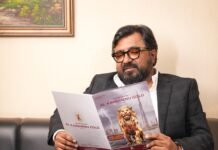
Australia: May 3, 2025
In a federal election that could shape the country’s future. This election decides who will become the next Prime Minister—current PM Anthony Albanese from the Labor Party or Peter Dutton from the Liberal-National Coalition. Many people across the nation are closely watching this vote, as it comes during a time of rising living costs, housing troubles, and debates on climate, immigration, and healthcare. The election will also help define Australia’s place in the world and how the country handles major issues like inflation, renewable energy, and public services.
In Australia’s federal election, voters choose members for both the House of Representatives and the Senate. All 150 seats in the House of Representatives are up for election, as well as 40 of the 76 seats in the Senate. The political party or coalition that gets the majority of seats in the House of Representatives will form the government, and their leader becomes the Prime Minister. The Labor Party, led by Anthony Albanese, is trying to hold onto power, while the Liberal-National Coalition, led by Peter Dutton, is hoping to return to government.
Voting in Australia is compulsory. This means every Australian citizen aged 18 or older must vote. The country uses a system called preferential voting, where voters rank the candidates in order of preference—1, 2, 3, and so on. If no candidate wins a majority of votes straight away, the preferences are counted until one candidate reaches the majority. This system often makes smaller parties and independent candidates more powerful in close races.
One of the biggest concerns for voters in this election is the rising cost of living. Everyday Australians are struggling with higher prices for food, fuel, rent, and electricity. The Labor Party has promised to cut the lowest income tax rate from 16% to 14% by 2026 and continue offering a $150 energy rebate for households and small businesses. This is meant to help people deal with energy bills. On the other hand, the Liberal-National Coalition plans to cancel Labor’s tax cuts and instead reduce fuel prices by temporarily halving the fuel tax for 12 months. This could cut petrol prices by around 25 cents per litre, helping people who rely on cars every day.
Housing affordability is another major issue. Many Australians, especially young people and families, are finding it hard to buy a home or even rent. Labor’s plan is to build 1.2 million homes by 2029, with the help of its $10 billion Housing Australia Future Fund. This includes 40,000 affordable and social housing units. Labor also wants to support 40,000 first-time home buyers by paying up to 40% of their deposit. In contrast, Peter Dutton’s Coalition wants to scrap this housing fund and instead invest $5 billion in roads and services to speed up new housing projects. The Coalition also wants Australians to be allowed to take out up to $50,000 from their superannuation savings to help buy their first home. Critics argue this might increase housing demand and push prices higher.
Energy and climate policy are major dividing lines between the two leaders. Anthony Albanese’s Labor Party wants 82% of Australia’s electricity to come from renewable sources like solar and wind by 2030. The party has promised to reduce carbon emissions by 43% compared to 2005 levels by 2030, and to achieve net-zero emissions by 2050. Labor’s plan includes public investment in clean energy projects and better electricity grids. Meanwhile, Peter Dutton’s Coalition is taking a very different approach. They propose building seven government-owned nuclear power plants and keeping coal plants running longer. They also want to increase natural gas production. Although both parties agree on a net-zero target by 2050, their plans to get there are very different.
Immigration is another big concern in this election, especially in big cities where housing, public transport, and services are under pressure. After record migration numbers in 2022 and 2023, both parties are planning cuts. Labor wants to reduce net overseas migration from more than 500,000 to 260,000 people per year. The government also plans to slow the number of international students unless universities build more accommodation. The Coalition wants to go even further, cutting permanent migration from 185,000 to 140,000 people a year for the next two years. They also want a two-year ban on foreign investors buying existing homes and plan to reduce Australia’s refugee intake.
Healthcare is always a major issue in Australian elections. Labor has committed to spending $8.5 billion to encourage GPs to bulk-bill more patients, which means no out-of-pocket costs for basic doctor visits. The government also wants to lower the maximum price for prescription medicines from $31.60 to $25 and spend over $500 million on women’s health services. Labor plans to open 50 urgent care clinics across the country. The Coalition says it will match many of these promises and go further by increasing the number of psychology sessions covered by Medicare and opening four new urgent care clinics.
Looking at the leaders, Anthony Albanese has served as Prime Minister since 2022 and has been praised for his focus on social welfare, renewable energy, and job creation. His “Future Made in Australia” policy supports building solar panels, batteries, and other green technology at home rather than importing them. His leadership style is seen as steady and collaborative. Peter Dutton, the leader of the Liberal-National Coalition, is a former police officer known for his strong positions on border protection, law enforcement, and defense. He wants to cut spending, support traditional energy, and appeal to conservative voters. His nuclear energy plan and tighter immigration policy have sparked both support and criticism.
As of election day, polls suggest that Labor may form a minority government, meaning they would need support from independents and smaller parties to pass laws. There is also a possibility that the Coalition could win enough seats to form government again. Voter frustration is growing over issues like inflation and government performance, and many Australians are turning to minor parties such as the Greens, One Nation, and independents. The preferential voting system means these smaller parties could hold real power, especially if no major party wins a clear majority.
Today’s election is more than just a contest between two leaders. It is a test of Australia’s direction on many long-term issues that affect everyday life. The next government will have to manage inflation, invest in housing, handle climate change, improve healthcare, and decide who can migrate to the country. These decisions will affect millions of lives. As Australians vote, they are choosing not just a Prime Minister, but also a vision for how the country tackles its biggest challenges.































